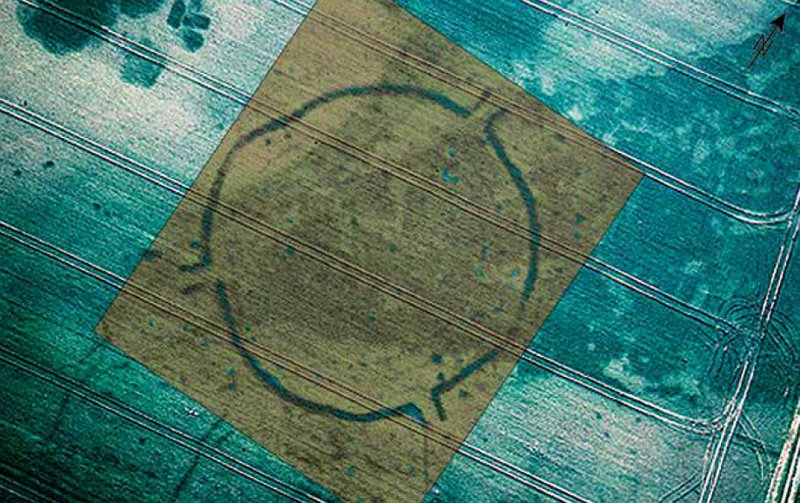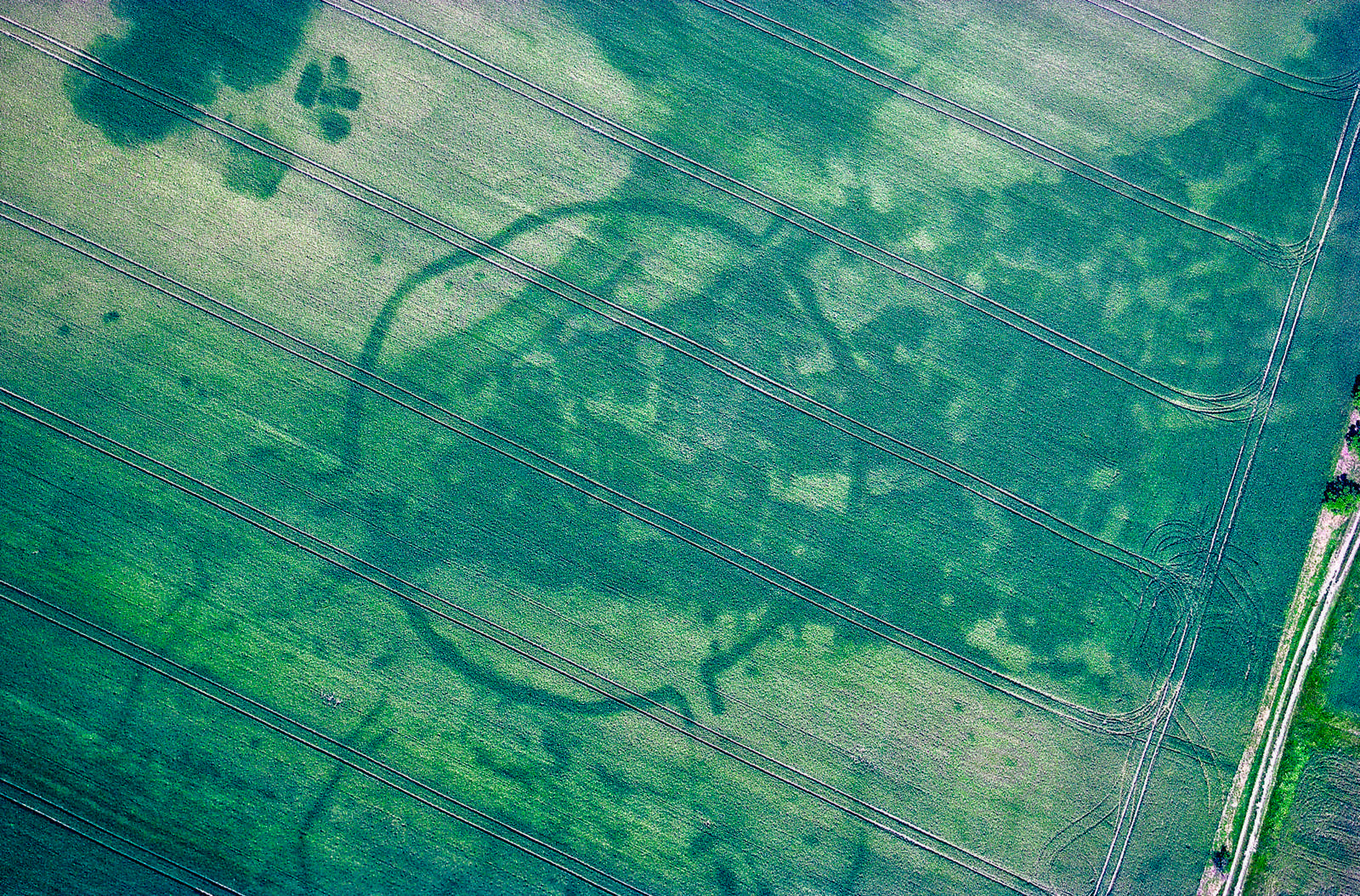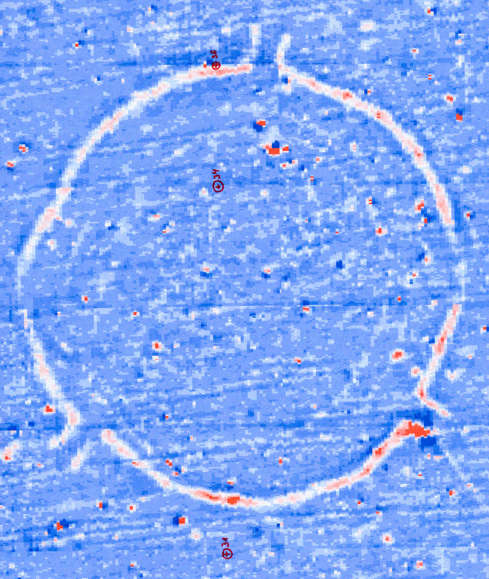The discovery
The discovery of the Goseck circular ditched enclosure is primarily due to aerial archaeology.
As early as the 1970s, agricultural pilots noticed vegetation anomalies in the farmland area near Goseck. In the early 1990s, these structures were so to say rediscovered, by the first archaeological aerial surveys:
At first, Otto Braasch conducted targeted aerial photo surveys in 1991 for the State Office, which at that time was called "State Museum for Prehistory - Research Centre for the Districts of Halle and Magdeburg". On 11 June, he discovered the circular ditched enclosure at Goseck, which appeared as a slightly distorted ovate roundel in a field of maize stubble. Afterwards, Ralf Schwarz undertook further aerial surveys and comprehensively documented the findings.
The evaluation of the images showed the first traces of an almost circular ditch, which was interrupted by gates in the north, south-east, and south-west. The two palisade rings inside the complex as well as numerous pits were also clearly visible in the aerial photographs.
Geophysical prospection
In 1995 Alfred R. Volker conducted the first geophysical surveys to supplement the aerial photographs. In this way, the circular ditched enclosure was mapped non-destructively and recorded to scale over its entire area. The measurements confirmed the structures already visible in the aerial photograph and revealed also further features, including various pits inside and outside the circular ditch complex.
The superimposition of aerial photography and geophysical measurements made the features of the circular ditch complex particularly clear. This created ideal conditions for a targeted archaeological investigation of the features.
Geomagnetics
Geomagnetic investigations make visible differences in the magnetic content of the soil. Human intervention changes the magnetic content.
Especially humus-rich soil material is more magnetic than the natural ground due to decomposition processes. Wood decomposing bacteria also leave behind highly magnetic material after they die.
Post pits or rubbish pits can be detected in this way non-destructively.

The aerial photographs clearly showed a threat to the archaeological monument. Since the intensive agricultural use of the area made the destruction of the features foreseeable, the State Office for Heritage Management and Archaeology Saxony-Anhalt decided to excavate the site.
In cooperation with the Institute for Art History and Archaeologies of Europe at the Martin Luther University Halle-Wittenberg, the site was finally completely excavated in three campaigns from 2002 to 2004 as part of teaching and research excavations. A total area of 0.7 ha was archaeologically investigated and recorded.
The interdisciplinary research project "Kreisgrabenanlage Goseck - Archäologie multimedial" (Goseck circular ditched enclosure – multimedia archaeology) at the Institute for Art History and Archaeologies of Europe pursued the goal, beyond archaeological work, of breaking new ground in archaeological practice through proactive PR work and digital documentation methods.
Thus, the ongoing excavations were already the subject of publicity measures that helped archaeology in Saxony-Anhalt in general and the circular ditched enclosure site of Goseck in particular to achieve special prominence in the public perception. This also later made it possible to raise funds for a 1:1 reconstruction of the circular ditch complex at the original site and to realise an exhibition in the Visitor Centre at Goseck Palace.
In order to gain insights into the state of preservation of the complex, the archaeologists opened the first trial trench in 2002. Already at a depth of 40 to 50 cm, they came across the features of the circular ditched enclosure. Within three weeks, the researchers examined the ditch and the narrow palisade trenches in the east of the complex. The first pottery finds confirmed the dating to the time of the Stroke-ornamented Pottery Culture (c. 4900 to 4600 BC). The circular ditch proved to be V-shaped. Outside the ditch, pits and house features of the Bronze Age appeared. A child's grave from the Linear Pottery Culture and another burial were the highlights of the first excavation campaign.
In the summer of 2003, the excavation team continued their work in a 1,000 square metre trench: this time, the focus was on the construction of the south-east gate. A webcam accompanied the five-week excavation. People from all over the world were thus able to follow the excavations live from their home. The excavations produced an unexpected picture: both palisade trenches were interrupted exactly on the alignment of the south-east gate. The outer row of posts turned inwards pincer shaped. In the gate area, the archaeologists also discovered mysterious pits whose walls showed traces of fire. One of the pits contained the right hand of a human.
In 2004, the circular ditched enclosure was finally excavated in its entirety. Over a period of seven months, the archaeologists, assisted by pupils from Naumburg and excavation assistants from Weißenfels, investigated an area of 6,000 square metres.
The complete excavation yielded a wealth of new results. Soil scientists developed initial theses on the reconstruction of the refilling process of the circular ditch and the landscape development. The features of the circular ditch indicated the existence of an external earthen bank built from material excavated from the ditch.
In June 2005, work began on the reconstruction of the circular ditched enclosure. The archaeologists decided on a reconstruction that shows the condition of the already partially refilled circular ditch at the end of the period of use of the circular ditched enclosure. For the palisades, 2,300 oak trunks were felled in the nearby Pödelist forest.

























